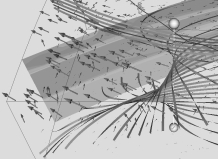|
This advanced geodynamics class discusses the numerical solution of
continuum mechanics problems as applied to geological processes in the
solid Earth. Quantitative skills to be learned are useful for all
Earth scientists, but the focus of the class is on tectonophysics and
mantle convection problems. We briefly review math and continuum
mechanics fundamentals, then discuss ordinary differential equations,
and spend the majority of the class discussing finite difference and
element solutions to partial differential equations. Every subject is
accompanied by hands-on Matlab programming exrcises.
Geodynamics students should take the sequence of GEOL534 (Intro
Geodynamics), 540, and 599 (Deep Earth Seminar).
Online material
Cource structure
- Term: Fall 2008
- Format: The class consists of lectures, computer exercises,
student presentations, and discussion of readings.
- Instructor: Thorsten Becker
- Texts:
- Required
- Recommended
- "Numerical Recipes in C. The art of scientific computing." Press
et al., Cambridge U Press, 2nd edition, 1992.
This is the place to start before doing any numerical work
and a standard reference. The current, 3rd 2007 edition is only
available in the object-oriented C++ language; it is updated and
more complete, but if you get a used 2nd edition, that will
do. Also, PDFs of the 2nd edition may still be available freely as
PDF online.
- "Geodynamics", D. Turcotte and G. Schubert, 2nd Edition, Cambridge
U Press, 2001.
A standard reference for geodynamics. While the
notation could be more elegant, still a highly useful book that
defined the field; available as paperback.
- For finite element details
- "The finite element method. Linear static and dynamic finite
element analysis." T. J. R. Hughes, Dover, 2000.
The class, and
common mantle dynamics codes such as ConMan and Citcom, follow the
notation of this nice book which is also not too expensive as
paperback.
- Meeting times:
Tuesdays 3:30-6:30pm, ZHS264 and ZHS130 (computer lab).
- Evaluation:
The course work will include a mix of regular problem sets, reading
and programming/modeling exercises. Students are expected to work
toward solving a specific research problem as a final project. There
will be no exam, and evaluation will be based on class participation
(10%), problem sets (50%), and final project (40%).
- Prerequisites:
MATH 126; corequisite: PHYS 135bL or PHYS 152L, GEOL440; GEOL534 or
similar recommended (math reqs can be waived, inquire with
instructor). The class assumes basic familiarity with the internal
structure of the Earth (440), geophysical methods (440), and plate
tectonics (440, 534).
Syllabus
- Orientational meeting - August 22
- Week 1 (Aug 25)
Introduction: Examples for numerical methods in Earth Sciences;
Overview of numerical methods; Computer hardware; Computer Language;
Principles of Programming. Exercise: Matlab programming
Notes:
Introduction
Handout:
Math
Problem set: Matlab
- Week 2 (Sep 1)
Ordinary differential equations: Definition of ODEs. Initial value
problems. Euler method. Taylor expansions. Accuracy of numerical
methods. Midpoint method, 4th order Runge Kutta. Exercise: Program
and solve Lorentz equations.
Notes:
ODEs
Problem set: ODEs
- Week 3 (Sep 8, SCEC: no lecture, but homework assignment)
Scaling analysis; Non-dimensionalization; Non-dimensional numbers
(Rayleigh, Prandtl, Peclet, Reynolds, Deborah). Stokes velocities
for Newtonian and non-Newtonian rheology; shear layers
Notes/problem set: Scaling
- Week 4 (Sep 15)
Finite differences I: 1-D heat equation. Explicit solution of
diffusion problems. Stability.
Notes/problem set:
Explicit
FD
- Week 5 (Sep 22)
Finite differences II: Implicit methods. Crank-Nicolson method. Order
of spatial and temporal accuracy. Stability conditions. Neumann and
Dirichlet boundary conditions. Sparse matrices,
triangularity. Linear systems of equations. Heat equation in 1-D.
Notes/problem set:
Implicit
FD methods
- Week 6 (Sep 29)
Finite differences III: Non-linear equations. Darcy flow equation for
pressure-dependent diffusivity. Two-dimensional heat equation,
solution with fully explicit and fully implicit methods. Comparison
with analytical solutions.
Notes/problem set:
Non-linear
and 2-D FD methods
- Week 7 (Oct 6)
Finite differences IV: Advection equation for heat transport. FTCS
method and stability. Lax method, Courant criterion. Upwind
schemes. Staggered leapfrog. Semi-Lagrangian methods.
Advection-diffusion combos in 2-D, operator splitting.
Notes/problem set:
Advection
equations and combos
- Week 8 (Oct 13)
Finite elements I: Introduction to the finite element method. Strong
and weak forms of PDEs. Discretization of domains into finite
elements. Shape functions. Bilinear forms. Variational approaches,
virtual work. Galerkin method. One-dimensional heat equation
example.
Notes:
FE Intro
- Week 9 (Oct 20)
Finite elements II: Local and global coordinate systems. Change of
variables during integration. Matrix assembly. Solution of linear
systems of equations, direct and iterative methods. LU
decomposition, Cholesky. Jacobi, Gauss-Seidel, Conjugate gradient,
and multigrid methods.
Notes:
FE
Implementation
Problem set:
1-D
FE implementation and matrix inversion
- Week 10 (Oct 27)
Finite elements III: 2D boundary value problems. Isoparametric
elements. Jacobian; global and element-local coordinates. Numerical
integration using Gauss quadrature. Triangular and quadrilateral
shape functions. Meshing using triangles. Solution of 2-D heat
equation.
Notes:
FE
2D,
time
dependent solution
Problem set:
2-D
FE heat equation
- Week 11 (Nov 3)
Finite elements IV: Compressible elastic problems. Elastic moduli,
plane stress, plane strain. Gradient operator,
elasticity matrix, engineering strain convection. Visualization of
stress states, eigensystems.
Problem set:
2-D
FE elastic
- Week 12 (Nov 9)
Finite elements V: Compressible and incompressible elasticity and
Stokes flow. Mixed formulation with discontinuous
pressure. Powell-Hestenen iterations.
Notes:
Incompressible
elastic/fluid problem
Problem set:
2-D
FE incompressible Stokes
- Weeks 13, 14 and 15 (Nov 17, Nov 25 and Dec 01)
Joint project work in computer lab.
Note on Disability Services and Programs
Students requesting academic accommodations based on a disability are
required to register with Disability Services and Programs (DSP) each
semester. A letter of verification for approved accommodations can be
obtained from DSP when adequate documentation is filed. Please be sure
the letter is delivered to us (or to your TA) as early in the semester
as possible. DSP is open Monday-Friday, 8:30-5:00pm. The office is in
STU301 and the phone number is (213) 740-0776.
Updated: June 25, 2025
(c) Thorsten Becker, 1997-2025.
|
